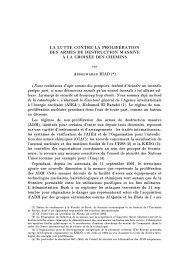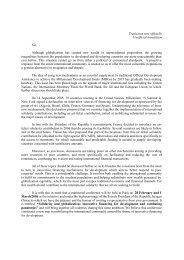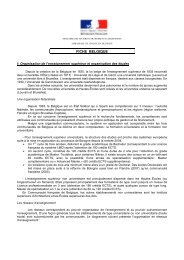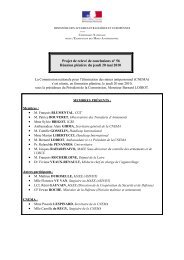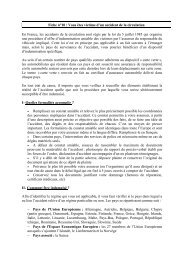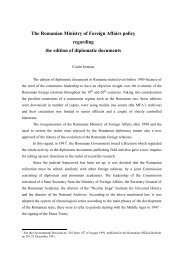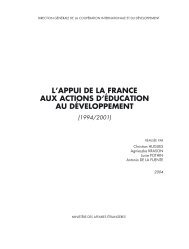From Exotics to Brainwashers: Portraying New Religions in Mass ...
From Exotics to Brainwashers: Portraying New Religions in Mass ...
From Exotics to Brainwashers: Portraying New Religions in Mass ...
You also want an ePaper? Increase the reach of your titles
YUMPU automatically turns print PDFs into web optimized ePapers that Google loves.
Religion Compass 1/1 (2007): 214–228, 10.1111/j.1749-8171.2006.00001.x<br />
<strong>From</strong> <strong>Exotics</strong> <strong>to</strong> <strong>Bra<strong>in</strong>washers</strong>: <strong>Portray<strong>in</strong>g</strong> <strong>New</strong><br />
<strong>Religions</strong> <strong>in</strong> <strong>Mass</strong> Media<br />
Sean McCloud*<br />
The University of North Carol<strong>in</strong>a at Charlotte<br />
Abstract<br />
This essay exam<strong>in</strong>es how American magaz<strong>in</strong>es have portrayed new religions s<strong>in</strong>ce<br />
the World War II. Media depictions have changed dramatically from the 1950s <strong>to</strong><br />
the present. Specifically, journalists <strong>in</strong> the 1950s and early 1960s used the dual Cold<br />
War themes of exoticism and subversion <strong>to</strong> depict new religions. In the late 1960s<br />
and early 1970s, subjects and themes began <strong>to</strong> change. <strong>New</strong>smagaz<strong>in</strong>es ambivalently<br />
reported on the gurus, Asian new religions, and occult spirituality attract<strong>in</strong>g some<br />
<strong>in</strong> the burgeon<strong>in</strong>g youth counterculture with a mixture of exoticism and war<strong>in</strong>ess.<br />
By the mid-1970s, media images became more om<strong>in</strong>ous. <strong>New</strong>s, general <strong>in</strong>terest,<br />
and enterta<strong>in</strong>ment media represented new religions as a grow<strong>in</strong>g “cult menace”<br />
and highlighted the dangers that bra<strong>in</strong>wash<strong>in</strong>g groups posed <strong>to</strong> unsuspect<strong>in</strong>g<br />
followers. The 1978 Jones<strong>to</strong>wn mass suicide seemed <strong>to</strong> confirm such negative cult<br />
stereotypes, lead<strong>in</strong>g <strong>to</strong> homogenous portrayals of new religions that cont<strong>in</strong>ued<br />
through the 1990s. In expla<strong>in</strong><strong>in</strong>g such changes over time, the essay ends by propos<strong>in</strong>g<br />
five complimentary theses for understand<strong>in</strong>g late-twentieth-century mass media<br />
representations of new religions.<br />
Introduction<br />
In 1959 Look magaz<strong>in</strong>e featured a pic<strong>to</strong>rial of a religious commune called the<br />
Wisdom, Knowledge, Faith and Love Founta<strong>in</strong> of the World (WKFL).<br />
The article was titled “California’s Offbeat <strong>Religions</strong>: ‘We Love You.’ ” The<br />
pho<strong>to</strong>-essay <strong>in</strong>cluded eight pictures of the group. The first showed members<br />
stand<strong>in</strong>g <strong>in</strong> the dark, hold<strong>in</strong>g candles, clothed <strong>in</strong> long robes, and star<strong>in</strong>g<br />
grimly at the camera. In successive shots we saw members hugg<strong>in</strong>g, a<br />
novitiate receiv<strong>in</strong>g a blood test, and one member hold<strong>in</strong>g two children.The<br />
f<strong>in</strong>al page featured three pho<strong>to</strong>graphs of a woman identified as “Bishop<br />
Mary.” In all three she was shown perform<strong>in</strong>g an improvisational dance <strong>to</strong><br />
classical music. “Like Bishop Mary,” one caption read, “all Founta<strong>in</strong><br />
members are ‘creativity-conscious’ ” (Brossard 1959, 102). After the <strong>in</strong>itial<br />
om<strong>in</strong>ous pho<strong>to</strong>graph, the commune appeared colorfully offbeat. Look’s<br />
pic<strong>to</strong>rial and accompany<strong>in</strong>g words made the group appear more theatrical<br />
than solemn, and the magaz<strong>in</strong>e’s frame did not suggest it was controversial<br />
– let alone dangerous.<br />
© Blackwell Publish<strong>in</strong>g 2006
<strong>New</strong> Religious Movements <strong>in</strong> <strong>Mass</strong> Media . 215<br />
This is strik<strong>in</strong>g, because the group was steeped <strong>in</strong> controversy and violence.<br />
Krishna Venta, the commune’s founder, was killed <strong>in</strong> 1958 when two<br />
disgruntled male followers blew him up with twenty sticks of dynamite.<br />
These apostates accused Venta of illicit sexual relations with female members,<br />
<strong>in</strong>clud<strong>in</strong>g underage girls (Mathison 1960). But national magaz<strong>in</strong>e coverage,<br />
both before and after Venta’s murder, played down these seamy details. A<br />
few articles failed <strong>to</strong> even mention the specific charges aga<strong>in</strong>st the founder.<br />
Look, whose feature on the commune appeared eight months after Venta’s<br />
death, only noted that he “was dynamited <strong>to</strong> bits <strong>in</strong> his office last year by<br />
two members who felt he was guilty of malpractices” (Brossard 1959,<br />
101). While many magaz<strong>in</strong>e writers did detail accusations aga<strong>in</strong>st Venta,<br />
their <strong>to</strong>ne was often more satirical than critical or forebod<strong>in</strong>g. In the Look<br />
article, for example, Chandler Brossard recounted the charges with humor<br />
and concluded that the post-Venta WKFL was “a bit bemused, but entirely<br />
impressive and loveable” (Brossard 1959, 101).<br />
Contrast the 1950s coverage of WKFL and Krishna Venta with the 1990s<br />
treatment of the Branch Davidians and their prophetic leader David Koresh.<br />
On April 19, 1993, the Branch Davidian commune outside Waco, Texas,<br />
burned <strong>to</strong> the ground with 74 people <strong>in</strong>side. This tragedy entailed the end<strong>in</strong>g<br />
of a fifty-one day standoff between the Davidians and agents from the FBI<br />
and the Bureau of Alcohol,Tobacco, and Firearms, which had unsuccessfully<br />
attempted <strong>to</strong> raid the commune on February 28 under suspicion that the<br />
religious group was s<strong>to</strong>ckpil<strong>in</strong>g illegal guns. <strong>From</strong> the beg<strong>in</strong>n<strong>in</strong>g of the<br />
standoff, newspaper, magaz<strong>in</strong>e, and television journalists described Koresh,<br />
<strong>in</strong> Time’s words, as a “preacherly hypnotist” who bra<strong>in</strong>washed his hapless<br />
followers (Morrow 1993, 34). Koresh, like Venta, was accused of hav<strong>in</strong>g<br />
illicit relations with a number of women <strong>in</strong> the group, <strong>in</strong>clud<strong>in</strong>g fourteenyear-old<br />
girls. And also like Venta, these accusations were confirmed by<br />
members. Rumors of child abuse with<strong>in</strong> the Davidian commune also<br />
circulated. But unlike the 1950s and 1960s s<strong>to</strong>ries, journalists report<strong>in</strong>g on<br />
these events framed them as moral atrocities and Koresh as a dangerous<br />
deviant. What accounts for this dramatic difference <strong>in</strong> coverage?<br />
In the last thirty years, the word “cult,” <strong>to</strong>day’s most common mass media<br />
moniker for new religions, has lost any descriptive, sociological mean<strong>in</strong>g it<br />
may have once had. It now conjures images of bra<strong>in</strong>wash<strong>in</strong>g, coercion,<br />
deception, exploitation, perversion, and religious fraud. For many Americans<br />
these associations have become doxa – those socially constructed op<strong>in</strong>ions,<br />
assumptions, and <strong>in</strong>cl<strong>in</strong>ations so taken for granted that they seem natural.<br />
Such associations have been particularly strong <strong>in</strong> American news media.<br />
(Richardson and van Driel 1997; Shupe 1997;Wright 1997) Accord<strong>in</strong>g <strong>to</strong><br />
many scholars, the associations between new religions and the “cult menace”<br />
are largely due <strong>to</strong> the “Anti-Cult Movement” (ACM), a loosely organized<br />
group of parents, psychiatrists, and clergy who throughout the 1970s <strong>to</strong> the<br />
1990s lobbied various governments and went <strong>to</strong> court <strong>to</strong> legally restrict the<br />
activities of many new religious movements. Some even kidnapped their<br />
© Blackwell Publish<strong>in</strong>g 2006 Religion Compass 1/1 (2007): 214–228, 10.1111/j.1749-8171.2006.00001.x
216 . Sean McCloud<br />
sons and daughters <strong>to</strong> remove them from certa<strong>in</strong> religions. (Bromley and<br />
Shupe 1980; Beckford 1999; Mel<strong>to</strong>n 1999; Shupe and Bromley 1994) One<br />
scholar credits the ACM with creat<strong>in</strong>g the category “cult” and suggests that<br />
“pr<strong>in</strong>t and broadcast media for the most part uncritically accepted the ACM’s<br />
analysis” of new religions (Greil 1996, 56–57; see also Richardson 1993).<br />
While the ACM certa<strong>in</strong>ly played a role <strong>in</strong> the <strong>in</strong>creas<strong>in</strong>gly negative media<br />
coverage of new religions, here I argue that the development of the “cult<br />
menace” motifs that dom<strong>in</strong>ated coverage of Koresh and the Branch Davidians<br />
was also part of a larger his<strong>to</strong>rical shift <strong>in</strong> journalistic discourses about<br />
American “ma<strong>in</strong>stream” and “fr<strong>in</strong>ge” religions. In other words, the way<br />
national journalists portrayed, or “framed,” new religions changed over time<br />
<strong>in</strong> ways that led <strong>to</strong> <strong>in</strong>creas<strong>in</strong>gly om<strong>in</strong>ous portrayals. Specifically, I argue that<br />
national pr<strong>in</strong>t media depictions of the American religious fr<strong>in</strong>ge changed<br />
significantly from the 1950s <strong>to</strong> the early 1990s (McCloud 2004). I suggest<br />
three dist<strong>in</strong>ct periods. First, <strong>in</strong> the Cold War ’50s and ’60s, the most<br />
prom<strong>in</strong>ent fr<strong>in</strong>ge portrayals focused on work<strong>in</strong>g-class white and African<br />
American groups, as well as certa<strong>in</strong> religions prom<strong>in</strong>ent <strong>in</strong> California. In a<br />
period marked by the rhe<strong>to</strong>ric of an American cultural consensus set aga<strong>in</strong>st<br />
“Godless communism,” periodicals such as Time, <strong>New</strong>sweek, U.S. <strong>New</strong>s and<br />
World Report,Saturday Even<strong>in</strong>g Post,Life, and Look reported on the “California<br />
cults” and other groups such as the Nation of Islam, us<strong>in</strong>g themes of mass<br />
movements, exoticism, and subversion.<br />
In the second period, from the late 1960s through early 1970s, subjects<br />
and themes changed. Cold War consensus ideology yielded <strong>to</strong> grow<strong>in</strong>g<br />
recognition of cultural diversity spurred by the civil rights and youth counterculture<br />
movements. At the same time, magaz<strong>in</strong>e coverage ambivalently<br />
framed the gurus, Asian new religions, occult spirituality, and Evangelical<br />
Jesus movements attract<strong>in</strong>g white, middle- and upper-middle-class youth.<br />
Eventually, coverage would also feature the grievances of a grow<strong>in</strong>g “anticult<br />
movement” made up of parents who wanted <strong>to</strong> remove their adult children<br />
from these groups.<br />
In the third period, beg<strong>in</strong>n<strong>in</strong>g <strong>in</strong> the mid-1970s, journalistic images of<br />
the fr<strong>in</strong>ge darkened. Magaz<strong>in</strong>es like <strong>New</strong>sweek, McCall’s, and Reader’s Digest<br />
promoted the image of a grow<strong>in</strong>g cult menace by highlight<strong>in</strong>g the dangers<br />
that dicta<strong>to</strong>rial leaders of fr<strong>in</strong>ge groups posed <strong>to</strong> unsuspect<strong>in</strong>g ma<strong>in</strong>stream<br />
<strong>in</strong>dividuals through bra<strong>in</strong>wash<strong>in</strong>g and coercion. The 1978 Jones<strong>to</strong>wn mass<br />
suicide seemed <strong>to</strong> confirm the negative stereotypes and led <strong>to</strong> homogenous<br />
portrayals <strong>in</strong> a variety of magaz<strong>in</strong>es. By 1993, this “cult menace” motif had<br />
become so thoroughly <strong>in</strong>scribed <strong>in</strong> many magaz<strong>in</strong>e narratives that it<br />
dom<strong>in</strong>ated news s<strong>to</strong>ries about the fifty-one-day Branch Davidian/FBI<br />
standoff <strong>in</strong> Waco.<br />
In what follows, I do three th<strong>in</strong>gs. First, I trace these three periods. Second, I<br />
po<strong>in</strong>t <strong>to</strong> the recent media “ma<strong>in</strong>stream<strong>in</strong>g” of a particular new religion,<br />
Neopaganism. Third, I propose five complimentary theses for understand<strong>in</strong>g<br />
late-twentieth-century mass media representations of new religions.<br />
© Blackwell Publish<strong>in</strong>g 2006 Religion Compass 1/1 (2007): 214–228, 10.1111/j.1749-8171.2006.00001.x
Exoticism and subversion dur<strong>in</strong>g the Cold War, 1955–65<br />
<strong>New</strong> Religious Movements <strong>in</strong> <strong>Mass</strong> Media . 217<br />
In the 1950s and early 1960s, the largest news and general <strong>in</strong>terest periodicals<br />
consistently used two somewhat contradic<strong>to</strong>ry themes <strong>to</strong> depict new religions<br />
and other groups they dubbed marg<strong>in</strong>al or offbeat. First, they portrayed the<br />
religious periphery as exotic – weird, colorful, and mysterious – yet mostly<br />
harmless. Second, and more ambivalently, writers and edi<strong>to</strong>rs depicted certa<strong>in</strong><br />
new religious movements as zealous, emotional, dogmatic, and potentially<br />
subversive. Magaz<strong>in</strong>e writers suggested that the high levels of commitment,<br />
enthusiasm, and exoticism characteristic of these groups were excessive,<br />
even “unhealthy.” Media portrayals occasionally implied that certa<strong>in</strong> new<br />
religions were un-American, and raised specters of foreignness and<br />
Communism when discuss<strong>in</strong>g certa<strong>in</strong> groups.<br />
Label<strong>in</strong>g someth<strong>in</strong>g “exotic” is a crucial step <strong>in</strong> identify<strong>in</strong>g its opposite,<br />
the domestic – that constituted as “normal” and “everyday.” Dur<strong>in</strong>g the<br />
1950s and early 1960s, the boundaries between exotic/domestic and<br />
ma<strong>in</strong>stream/fr<strong>in</strong>ge religions were <strong>in</strong> flux. Depict<strong>in</strong>g certa<strong>in</strong> religious groups<br />
– or more accurately, the characteristics of certa<strong>in</strong> groups – as marg<strong>in</strong>al<br />
established new boundaries around a chang<strong>in</strong>g, vaguely def<strong>in</strong>ed conception<br />
of “ma<strong>in</strong>stream.” One place journalists associated with exotic new religions<br />
was California. Even though many of California’s so-called “cults” were<br />
well established outside the state, journalists <strong>in</strong> the largest periodicals – who<br />
were overwhelm<strong>in</strong>gly based <strong>in</strong> the northeast – consistently associated<br />
California with exotic spirituality. For example, the subtitle of Louie<br />
Rob<strong>in</strong>son’s 1963 Ebony article, “The K<strong>in</strong>gdom of K<strong>in</strong>g Narcisse,” read<br />
“California breeds another bizarre but colorful sect” (112). Similarly, <strong>in</strong><br />
1956, <strong>New</strong>sweek published “The Way of the Cults.” The s<strong>to</strong>ry focused on<br />
the numerous “sects <strong>in</strong> the Los Angeles area which can best – or most<br />
conservatively – be described as odd-look<strong>in</strong>g <strong>to</strong> almost anybody who does<br />
not live <strong>in</strong> southern California” (“Way of the Cults” 1956, 102). The<br />
unnamed authors dubbed California the “cult center of the United States”<br />
and offered several explanations. “One theory,” <strong>New</strong>sweek wrote, “is that<br />
cults attract the elderly, and so does California” (“Way of the Cults” 1956,<br />
102). Other reasons <strong>in</strong>cluded the ease with which religions could ga<strong>in</strong> legal<br />
status <strong>in</strong> the state, the Los Angeles area’s responsiveness <strong>to</strong> the colorful, and<br />
the particularly deep emotional needs and gullibility of the city’s citizens. The<br />
writers briefly described several groups, <strong>in</strong>clud<strong>in</strong>g the Self-Realization<br />
Fellowship, Theosophical Society, Vedanta Society, and Aimee Semple<br />
McPherson’s Pentecostal Four-Square Gospel Church. “Some of these<br />
movements may strike the viewer-from-afar as positively odd,” <strong>New</strong>sweek<br />
concluded, “yet Los Angeles has proven that oddity, as some may call it,<br />
can attract wide and devoted follow<strong>in</strong>gs” (“Way of the Cults” 1956, 105).<br />
But new religious depictions dur<strong>in</strong>g the Cold War could also be om<strong>in</strong>ous,<br />
and the best example of this can be seen <strong>in</strong> coverage of the Nation of Islam.<br />
<strong>New</strong>s periodicals suggested that the Nation – an African American new<br />
© Blackwell Publish<strong>in</strong>g 2006 Religion Compass 1/1 (2007): 214–228, 10.1111/j.1749-8171.2006.00001.x
218 . Sean McCloud<br />
religion founded <strong>in</strong> 1930 that comb<strong>in</strong>ed orthodox Muslim practices,<br />
Evangelical Protestantism, and the new revelations and teach<strong>in</strong>gs of W. D.<br />
Fard and the Honorable Elijah Muhammad – posed a subversive threat <strong>to</strong><br />
the United States. For example, <strong>in</strong> 1959 U.S. <strong>New</strong>s and World Report<br />
published a feature article entitled “‘Black Supremacy’ Cult <strong>in</strong> U.S. – How<br />
Much of a Threat?”Answer<strong>in</strong>g this question, the anonymous writers asserted<br />
that the group had no apparent Communist or foreign connections, but<br />
could still pose a “foreign-like” threat <strong>to</strong> the nation.“In time of war,” they<br />
concluded, “the Muslims could present a major problem: they are taught<br />
they owe allegiance only <strong>to</strong> the flag of Islam” (“‘Black Supremacy’ Cult <strong>in</strong><br />
U.S.” 1959, 114). For reasons of “civic safety” and “national security,” U.S.<br />
<strong>New</strong>s reassured, federal and local authorities – and presumably the<br />
newsmagaz<strong>in</strong>e itself – would cont<strong>in</strong>ue <strong>to</strong> keep “close tabs on the strength<br />
and <strong>in</strong>fluence of this ‘Black Supremacy’ movement” (“ ‘Black Supremacy’<br />
Cult <strong>in</strong> U.S.” 1959, 114).<br />
His<strong>to</strong>rian Tom Englehardt suggests that “a nightmarish search for<br />
enemy-ness became the def<strong>in</strong><strong>in</strong>g, even obsessive domestic act of the Cold<br />
War years” (1995, 7). But Communism, he argues, proved a “bedevil<strong>in</strong>g”<br />
foe <strong>to</strong> p<strong>in</strong>po<strong>in</strong>t because “it was never fully identified with or conta<strong>in</strong>ed<br />
with<strong>in</strong> any s<strong>in</strong>gle ethnic or racial community” (99). For white journalists,<br />
however, the all-black Nation of Islam (NOI) served as an easily recognizable<br />
Cold War enemy. The racial make-up of the lower-class NOI had them<br />
fear<strong>in</strong>g imm<strong>in</strong>ent revolt, and fears about the “Black Muslims” were almost<br />
always articulated <strong>in</strong> the language of possibilities. Police chiefs <strong>to</strong>ld journalists<br />
that the group could cause problems <strong>in</strong> <strong>in</strong>ner cities. Journalists <strong>to</strong>ld readers<br />
the movement might be a war-time threat because they could potentially<br />
be used by Communists, Arabs, or some unidentified foreign enemies. At<br />
the heart of s<strong>to</strong>ries about the Nation of Islam was distanc<strong>in</strong>g and ambiguity:<br />
because we don’t know what they are capable of, we fear them.<br />
<strong>From</strong> exotics <strong>to</strong> dangerous deviants, 1966–72<br />
The period from the mid-1960s through the mid-1970s saw the beg<strong>in</strong>n<strong>in</strong>gs<br />
of the gradual shift <strong>in</strong> fr<strong>in</strong>ge and new religious movement representations<br />
from disda<strong>in</strong>ed exotics and potential subversives <strong>to</strong> <strong>in</strong>herently dangerous<br />
deviants. Political assass<strong>in</strong>ations, the Vietnam War and its atrocities, race<br />
riots, an energy crisis, the Watergate scandal, and the civil rights and<br />
countercultural movements marked the period as one <strong>in</strong> which the image<br />
of a unified American cultural consensus seemed <strong>in</strong>creas<strong>in</strong>gly distant. In<br />
addition <strong>to</strong> cover<strong>in</strong>g and comment<strong>in</strong>g on these social upheavals, magaz<strong>in</strong>es<br />
responded <strong>to</strong> concern over a grow<strong>in</strong>g generation gap, a vocal youth<br />
counterculture, and an apparent (although perhaps statistically unfounded)<br />
“cult explosion” by turn<strong>in</strong>g their attention away from groups such as the<br />
“California cults” and the Nation of Islam. Instead, they <strong>in</strong>creas<strong>in</strong>gly focused<br />
on the guru-based Asian religions, Evangelical Jesus Movements, and Occult<br />
© Blackwell Publish<strong>in</strong>g 2006 Religion Compass 1/1 (2007): 214–228, 10.1111/j.1749-8171.2006.00001.x
practices that were attract<strong>in</strong>g predom<strong>in</strong>antly white, middle- and upper-middleclass<br />
youth.<br />
In this same period, journalistic representations of new and alternative<br />
religions darkened. This can be seen <strong>in</strong> chang<strong>in</strong>g coverage of occult new<br />
religions and the Jesus Movement. For example, <strong>in</strong> 1966 the Saturday Even<strong>in</strong>g<br />
Post featured John Kobler’s essay, “Out for a Night at the Local Caldron.”<br />
“To her neighbors,” Kobler began, “Mrs. Eunice Jenk<strong>in</strong>s (as we will call<br />
her, <strong>to</strong> avoid alarm<strong>in</strong>g them) is a plump, cheerful London housewife who<br />
ex-emplifies middle-class, middle-aged British decorum. But at the approach<br />
of Halloween, she prepares <strong>to</strong> perform some of the most bizarre pagan rites<br />
<strong>to</strong> have survived <strong>in</strong><strong>to</strong> the 20th century” (Kobler 1966, 76). The article was<br />
about British Neopagan Wicca, an eclectic occult religious movement made<br />
up of loosely connected groups and <strong>in</strong>dividuals who look <strong>to</strong> nature-oriented,<br />
often polytheistic religions and myths for <strong>in</strong>spiration. Kobler gave a his<strong>to</strong>ry<br />
of the movement and its founder, Gerald Gardner. Kobler also <strong>in</strong>terviewed<br />
practic<strong>in</strong>g witches like Sybil Leek and Doreen Valiente. Throughout, he<br />
framed the British witches as curiosities who were simultaneously exotic<br />
and harmlessly domestic.<br />
Contrast Kobler’s piece <strong>to</strong> early 1970s s<strong>to</strong>ries <strong>in</strong> Time and <strong>New</strong>sweek<br />
suggest<strong>in</strong>g that dangerous – even murderous – Satanic groups lurked about<br />
the landscape (“Cult of the Occult” 1970; “The Occult: A Substitute Faith”<br />
1972). Such assertions were based more on rumor and supposition than any<br />
material evidence. But <strong>in</strong>clusion of these phan<strong>to</strong>m-like Satanists <strong>in</strong> occult<br />
s<strong>to</strong>ries served <strong>to</strong> darken depictions of the periphery, add<strong>in</strong>g dangerous<br />
deviancy <strong>to</strong> new religion report<strong>in</strong>g (Lippert 1990; Vic<strong>to</strong>r 1993).<br />
Initially, and like early s<strong>to</strong>ries on the occult, the largest news and general<br />
<strong>in</strong>terest magaz<strong>in</strong>es portrayed the Jesus Movement favorably. In a June 1971<br />
cover s<strong>to</strong>ry, Time concluded that “<strong>in</strong> a world filled with real and fancied<br />
demons for the young, the form their faith takes may be less important than<br />
the fact that they have it” (“<strong>New</strong> Rebel Cry 1971: 63), U.S. <strong>New</strong>s and World<br />
Report and Reader’s Digest concurred. But such coverage changed when vocal<br />
parents expressed more negative views, and these views appeared <strong>in</strong> news<br />
media. In the late summer of 1971,William Rambur, a retired navy officer<br />
from California, started “The Parent’s Committee <strong>to</strong> Free Our Sons and<br />
Daughters from the Children of God” after his daughter, a 22-year-old<br />
nurs<strong>in</strong>g student, jo<strong>in</strong>ed the apocalyptic Children of God commune. By the<br />
late 1970s, this small parent’s group would grow <strong>in</strong><strong>to</strong> a loosely organized national<br />
coalition of parents, pas<strong>to</strong>rs, and psychiatrists who lobbied aga<strong>in</strong>st “cults.”<br />
This Anti-Cult Movement eventually provided a new and dramatic set<br />
of idioms for journalists writ<strong>in</strong>g about the American religious fr<strong>in</strong>ge.<br />
The cult menace, 1973–93<br />
<strong>New</strong> Religious Movements <strong>in</strong> <strong>Mass</strong> Media . 219<br />
In 1975, Time published a s<strong>to</strong>ry about parents who were disgruntled over<br />
their children’s membership <strong>in</strong> Sun Myung Moon’s Unification Church.<br />
© Blackwell Publish<strong>in</strong>g 2006 Religion Compass 1/1 (2007): 214–228, 10.1111/j.1749-8171.2006.00001.x
220 . Sean McCloud<br />
“Around the country,” Time wrote,“hundreds of parents have been driven<br />
<strong>to</strong> near hysteria by changes <strong>in</strong> their convert children’s behavior and by<br />
reports of bra<strong>in</strong>wash<strong>in</strong>g” (“Mad About Moon” 1975, 44). Support<strong>in</strong>g<br />
parents’ fears, the newsmagaz<strong>in</strong>e noted that both ex-members and<br />
psychologists confirmed the bra<strong>in</strong>wash<strong>in</strong>g allegations. Today, the overwhelm<strong>in</strong>g<br />
majority of psychologists, sociologists, and religion scholars not<br />
only repudiate charges of bra<strong>in</strong>wash<strong>in</strong>g leveled aga<strong>in</strong>st new religions, they<br />
question whether such an activity even exists (Bromley and Richardson<br />
1983; Robb<strong>in</strong>s 1984; Richardson 1994; Dawson 1998). Rather than<br />
describ<strong>in</strong>g an actual process, they suggest,“bra<strong>in</strong>wash<strong>in</strong>g” is more accurately<br />
viewed as a rhe<strong>to</strong>rical term that negatively marks certa<strong>in</strong> religions the speaker<br />
doesn’t like. Although critics of bra<strong>in</strong>wash<strong>in</strong>g were even vocal <strong>in</strong> the 1970s,<br />
the period’s journalists selectively quoted “experts” and used the concept<br />
as if it were an undisputed scientific fact. Time, for example, quoted one<br />
defec<strong>to</strong>r’s charges of “psychological abuse” and “sublim<strong>in</strong>al fascism,” and<br />
further reported that “Harvard Psychiatrist John Clark Jr. recently testified<br />
<strong>in</strong> District of Columbia Superior Court that the ex-Moonies he had<br />
exam<strong>in</strong>ed seemed physically and emotionally exhausted; a few were<br />
psychotic” (“Mad About Moon” 1975, 44). The s<strong>to</strong>ry ended porten<strong>to</strong>usly,<br />
not<strong>in</strong>g that “Jack Kerry, the Moon watcher <strong>in</strong> the California at<strong>to</strong>rney<br />
general’s office, sees the movement as ‘extremely dangerous’ and adds:<br />
‘I th<strong>in</strong>k this whole situation is go<strong>in</strong>g <strong>to</strong> explode’” (“Mad About Moon”<br />
1975, 44).<br />
The Unification Church, a new religion comb<strong>in</strong><strong>in</strong>g aspects of Christianity<br />
with the revelations and biblical <strong>in</strong>terpretations of its founder Reverend Sun<br />
Myung Moon, was the archetypal cult of 1970s pr<strong>in</strong>t media. Founded <strong>in</strong><br />
Korea <strong>in</strong> 1954, the group, whose full name is the Holy Spirit Association<br />
for the Unification of World Christianity, attracted negative attention from<br />
some convert relatives and mass media <strong>in</strong> the United States for its aggressive<br />
proselytiz<strong>in</strong>g, <strong>to</strong>talistic communal liv<strong>in</strong>g, and large group wedd<strong>in</strong>gs. Various<br />
stripes of Christians and Jews also attacked Moon’s revela<strong>to</strong>ry scripture, The<br />
Div<strong>in</strong>e Pr<strong>in</strong>ciple, as heretical. Sociologist Anson Shupe suggests that “the<br />
Unification Church, among all other new religious movements or ‘cults,’<br />
has always been the bête noire of the modern anticult movement <strong>in</strong> America,”<br />
add<strong>in</strong>g that it “offers a veritable archetype of the dimensions that offend,<br />
<strong>in</strong>furiate, and threaten conventional society, thereby call<strong>in</strong>g down accusations<br />
of heresy and sett<strong>in</strong>g <strong>in</strong> motion the ritual process of assign<strong>in</strong>g the<br />
label ‘evil’” (Shupe 1987, 207). Along with bra<strong>in</strong>wash<strong>in</strong>g motifs, journalists<br />
blended tenuous allegations of deviant sex rituals and conspira<strong>to</strong>rial foreign<br />
connections with documented cases of deceptive California proselytiz<strong>in</strong>g<br />
and Moon’s antagonistic preach<strong>in</strong>g <strong>to</strong> make captivat<strong>in</strong>g – if not alarm<strong>in</strong>g –<br />
read<strong>in</strong>g.<br />
But the content of Unification Church coverage was not unique for its<br />
time. By the mid-1970s, charges of bra<strong>in</strong>wash<strong>in</strong>g, deception, fraud, and<br />
various improprieties appeared <strong>in</strong> most s<strong>to</strong>ries about groups journalists labeled<br />
© Blackwell Publish<strong>in</strong>g 2006 Religion Compass 1/1 (2007): 214–228, 10.1111/j.1749-8171.2006.00001.x
cults. Dur<strong>in</strong>g this time, Reader’s Digest expla<strong>in</strong>ed “How Cults Bilk All of<br />
Us” and detailed a “Rescue from a Fanatic Cult.” Parent’s Magaz<strong>in</strong>e asked<br />
“Could Your Child be Bra<strong>in</strong>washed?” while U.S. <strong>New</strong>s and World Report<br />
dared look “Beh<strong>in</strong>d the Cult Craze.” By the late 1970s the connections<br />
between cults, bra<strong>in</strong>wash<strong>in</strong>g, and fraudulence had become naturalized. In<br />
other words, these associations became unquestioned truths <strong>in</strong> magaz<strong>in</strong>e<br />
articles and for many Americans.<br />
Despite their ambivalence and occasional hostility <strong>to</strong>ward new religions,<br />
both newsmagaz<strong>in</strong>es and religious periodicals <strong>in</strong> the mid-1970s denounced<br />
deprogramm<strong>in</strong>g – the act of forcibly remov<strong>in</strong>g an <strong>in</strong>dividual from his or her<br />
religious group – as a civil rights violation. For both “secular” and religious<br />
journalists, neither zealotry nor doctr<strong>in</strong>al heresy constituted grounds <strong>to</strong><br />
violate an <strong>in</strong>dividual’s religious liberty. But some special and general <strong>in</strong>terest<br />
magaz<strong>in</strong>es – particularly family-oriented “homemaker” periodicals like Good<br />
Housekeep<strong>in</strong>g, McCall’s, and Reader’s Digest – <strong>to</strong>ok the opposite view. These<br />
journals, recount<strong>in</strong>g parents’ heroic rescues and deprogramm<strong>in</strong>gs of their<br />
cult-victimized children, foreshadowed the cult menace frames that all<br />
magaz<strong>in</strong>e genres would utilize after the 1978 Jones<strong>to</strong>wn mass suicide.<br />
JONESTOWN<br />
<strong>New</strong> Religious Movements <strong>in</strong> <strong>Mass</strong> Media . 221<br />
The Peoples Temple his<strong>to</strong>ry has been well documented <strong>in</strong> several useful<br />
works, and I will only briefly outl<strong>in</strong>e it here (Hall 1987; Chidester 1988;<br />
Maaga 1998). The church was founded by James Warren Jones <strong>in</strong> Indiana<br />
<strong>in</strong> 1956. In 1960, the group formally jo<strong>in</strong>ed the Disciples of Christ<br />
denom<strong>in</strong>ation. The early Peoples Temple stressed <strong>in</strong>terracial worship and<br />
civil rights. As the head m<strong>in</strong>ister, Jones also practiced faith heal<strong>in</strong>g. In 1965,<br />
Jones moved the church <strong>to</strong> California, partly because he feared nuclear war<br />
and had read that the state’s Redlands area was one place that might be<br />
spared from nuclear fallout. By the mid-1970s, the church was at an all-time<br />
high of between 5,000 <strong>to</strong> 7,000 members, with over sixty percent of<br />
the congregation African American. In 1975, Jones received positive<br />
endorsements from San Francisco’s mayor for humanitarian work. In 1977,<br />
he received the Mart<strong>in</strong> Luther K<strong>in</strong>g Jr. Humanitarian Award. With the<br />
exception of a few apostates, few even noticed the Peoples Temple, let alone<br />
saw it as a cultic threat.<br />
Dur<strong>in</strong>g the mid-1970s, Jones developed the idea of a farm<strong>in</strong>g commune<br />
<strong>in</strong> the South American jungles of Guyana. Believ<strong>in</strong>g that U.S. society was<br />
<strong>to</strong>o racist and classist, Jones sent the first church members <strong>to</strong> Guyana <strong>in</strong> 1975<br />
<strong>to</strong> create Jones<strong>to</strong>wn. Jones moved there <strong>in</strong> 1977. In 1978, pushed by the<br />
concern of church members’ relatives, Congressman Leo Ryan decided <strong>to</strong><br />
visit the commune. On his way back <strong>to</strong> the jungle airport, Ryan and some<br />
of his en<strong>to</strong>urage were murdered by Peoples Temple assass<strong>in</strong>s. Conv<strong>in</strong>ced<br />
that the U.S. military would respond by <strong>in</strong>vad<strong>in</strong>g Jones<strong>to</strong>wn, Jones and a<br />
small group of his assistants decided that the whole community should<br />
© Blackwell Publish<strong>in</strong>g 2006 Religion Compass 1/1 (2007): 214–228, 10.1111/j.1749-8171.2006.00001.x
222 . Sean McCloud<br />
commit suicide. Jones had preached “revolutionary suicide,” kill<strong>in</strong>g oneself<br />
<strong>to</strong> protest the world’s <strong>in</strong>justice, for years. Jones<strong>to</strong>wn members regularly<br />
conducted mass suicide drills known as “white nights.” On November 18,<br />
1978, it wasn’t a drill.<br />
On December 4, 1978, Time, <strong>New</strong>sweek, and U.S. <strong>New</strong>s and World Report<br />
published nearly identical s<strong>to</strong>ries on the mass suicide. Both Time and<br />
<strong>New</strong>sweek titled their covers “Cult of Death” and featured only slightly<br />
different pho<strong>to</strong>s of Jones<strong>to</strong>wn’s dead. All three suggested that Jim Jones used<br />
bra<strong>in</strong>wash<strong>in</strong>g <strong>to</strong> coerce his followers <strong>in</strong><strong>to</strong> committ<strong>in</strong>g suicide. Jones<strong>to</strong>wn<br />
coverage <strong>in</strong> the largest newsweeklies was both monolithic and strik<strong>in</strong>g <strong>in</strong><br />
its <strong>in</strong>dictment of cults. Religious periodicals such as America, Christian<br />
Century, and Christianity Today similarly expla<strong>in</strong>ed the tragedy <strong>in</strong> terms of<br />
bra<strong>in</strong>wash<strong>in</strong>g. Sociologist Eileen Barker has shown that Jones<strong>to</strong>wn proved<br />
<strong>to</strong> be the watershed event that made new religions synonymous with the<br />
cult menace (Barker 1986). The zealous exotics <strong>in</strong> Cold War mass<br />
movements had transformed <strong>in</strong><strong>to</strong> dangerous, bra<strong>in</strong>wash<strong>in</strong>g crim<strong>in</strong>als. The<br />
negative associations with the term cult had become assumed and thus<br />
unquestioned. It was the cult menace motifs of bra<strong>in</strong>wash<strong>in</strong>g, exploitation,<br />
fraud, and psychological <strong>in</strong>stability that made up the difference between the<br />
1950s coverage of Krishna Venta and the WKFL and David Koresh and the<br />
Branch Davidians <strong>in</strong> 1993.<br />
Similar <strong>to</strong> Jones<strong>to</strong>wn, the Branch Davidian tragedy had the immediate<br />
effect of giv<strong>in</strong>g anticult groups such as the Cult Awareness Network (CAN)<br />
a public voice through mass media outlets. But by mid-May 1993 – only a<br />
month later – the Waco <strong>in</strong>cident had virtually disappeared from the airwaves<br />
and newsstands. When it returned <strong>in</strong> a few summer and fall follow-ups, the<br />
journalistic portrayal of it had changed. Instead of tell<strong>in</strong>g the all-<strong>to</strong>o familiar<br />
s<strong>to</strong>ry of a maniacal cult leader who had bra<strong>in</strong>washed his followers and lead<br />
them <strong>to</strong> death, the new s<strong>to</strong>ries suggested government culpability for the<br />
standoff ’s violent end<strong>in</strong>g. Instead of featur<strong>in</strong>g anticultists tell<strong>in</strong>g readers what<br />
“cults” do, magaz<strong>in</strong>es such as <strong>New</strong>sweek turned <strong>to</strong> religious studies scholars<br />
for commentary. In some ways, the Waco <strong>in</strong>cident was the peak of the<br />
gradually decl<strong>in</strong><strong>in</strong>g <strong>in</strong>fluence of the Anti-Cult Movement <strong>in</strong> American mass<br />
media.<br />
“Ma<strong>in</strong>stream<strong>in</strong>g” new religions?<br />
The period from the late 1970s <strong>to</strong> the present witnessed the tragedies of the<br />
1978 Jones<strong>to</strong>wn mass suicide, the 1993 Branch Davidian conflagration, the<br />
1994 Solar Temple murder-suicides, the 1995 nerve gas attack on the Tokyo<br />
subway by Aum Sh<strong>in</strong>rikyo, and the 1997 mass suicide of the members of<br />
Heaven’s Gate. In part, the period from 1978 <strong>to</strong> present could be narrated<br />
through a series of so-called “cult controversies” <strong>in</strong> which a loosely organized<br />
Anti-Cult Movement charged certa<strong>in</strong> new religions with bra<strong>in</strong>wash<strong>in</strong>g and<br />
fought <strong>to</strong> impose legal restrictions on them. But at the same time, the period<br />
© Blackwell Publish<strong>in</strong>g 2006 Religion Compass 1/1 (2007): 214–228, 10.1111/j.1749-8171.2006.00001.x
<strong>New</strong> Religious Movements <strong>in</strong> <strong>Mass</strong> Media . 223<br />
saw the grow<strong>in</strong>g media acceptance of new religions such as Mormonism<br />
and Neopaganism.<br />
For example, an article appear<strong>in</strong>g on the Religion <strong>New</strong>swriter’s<br />
Association’s “Tips” webpage for journalists on Oc<strong>to</strong>ber 11, 2004, was titled<br />
“Wicca Moves <strong>in</strong><strong>to</strong> the Ma<strong>in</strong>stream.” The report described how Wicca,<br />
the largest branch of Neopaganism, had grown dramatically s<strong>in</strong>ce the 1960s<br />
and offered reporters a number of practitioners, academics, and other<br />
contacts. While the “ma<strong>in</strong>stream<strong>in</strong>g” of Wicca and Neopaganism suggested<br />
<strong>in</strong> the article might have been uneven <strong>in</strong> different regions of the country,<br />
the s<strong>to</strong>ry was certa<strong>in</strong>ly supported <strong>in</strong> the marketplace of American popular<br />
culture, where positive images of Wiccans were appear<strong>in</strong>g on the shelves<br />
of cha<strong>in</strong> books<strong>to</strong>res, <strong>in</strong> movies, and <strong>in</strong> children’s shows such as Car<strong>to</strong>on<br />
Network’s <strong>New</strong> Scooby Doo and Disney’s W.I.T.C.H. series. How other<br />
new religions currently fare <strong>in</strong> American mass media, and whether the future<br />
will hold further “ma<strong>in</strong>stream<strong>in</strong>g” of particular groups, are two pert<strong>in</strong>ent<br />
questions for <strong>in</strong>terested researchers <strong>to</strong> pursue.<br />
Five theses for understand<strong>in</strong>g mass media representations of new religions<br />
So why have the journalistic accounts of new religions provided by mass<br />
market magaz<strong>in</strong>es <strong>in</strong> the United States developed <strong>in</strong> this way? It appears<br />
that there are at least five fac<strong>to</strong>rs that should be taken <strong>in</strong><strong>to</strong> consideration.<br />
1. Journalists tapped <strong>in</strong><strong>to</strong> some longstand<strong>in</strong>g debates <strong>in</strong> American religious<br />
his<strong>to</strong>ry.<br />
Throughout the last fifty years, the largest news and general <strong>in</strong>terest<br />
magaz<strong>in</strong>es consistently dubbed new religious groups “fr<strong>in</strong>ge” that<br />
demonstrated high levels of religious zeal, dogma, and emotion. Label<strong>in</strong>g<br />
certa<strong>in</strong> religious practices and beliefs marg<strong>in</strong>al, writers and edi<strong>to</strong>rs <strong>in</strong> the<br />
largest news and general <strong>in</strong>terest magaz<strong>in</strong>es broached long-stand<strong>in</strong>g debates<br />
<strong>in</strong> American religious his<strong>to</strong>ry about emotional versus rational religion, exotic<br />
versus familiar spirituality, and normal versus abnormal levels of piety.<br />
Journalists acted as “heresiographers,” identify<strong>in</strong>g false or <strong>in</strong>authentic religion<br />
and thus symbolically establish<strong>in</strong>g boundaries between a ma<strong>in</strong>stream religious<br />
center and a suspect periphery.<br />
That journalists did this should not be surpris<strong>in</strong>g. Throughout American<br />
his<strong>to</strong>ry, clerics, journalists, politicians, and his<strong>to</strong>rians have labeled certa<strong>in</strong><br />
religious movements as central or peripheral <strong>to</strong> national and religious<br />
purposes. Take, for example, the antebellum debates over the compatibility<br />
of Roman Catholicism <strong>to</strong> American ideals. Nativists like Samuel Morse<br />
asserted that Catholic immigrants, because of their allegiance <strong>to</strong> the Pope,<br />
posed an imm<strong>in</strong>ent threat <strong>to</strong> American democracy. On the other side of the<br />
debate s<strong>to</strong>od Catholics like convert Orestes Brownson, who suggested that<br />
Catholicism was the religion actually best suited for the United States (Gaustad<br />
1993). In a country where the Constitution prohibits a state-sanctioned<br />
© Blackwell Publish<strong>in</strong>g 2006 Religion Compass 1/1 (2007): 214–228, 10.1111/j.1749-8171.2006.00001.x
224 . Sean McCloud<br />
church, <strong>in</strong>sider/outsider and orthodox/heretical classifications have often<br />
acted as a strategic substitute for socially and politically legitimat<strong>in</strong>g some<br />
groups and de-legitimiz<strong>in</strong>g others. Over the past four centuries, Catholics,<br />
Shakers, Mormons, Jehovah’s Witnesses, and others have been labeled<br />
heretical, cultic, and un-American. Scholars note that all of these groups<br />
have been subject <strong>to</strong> similar macabre and frequently unsubstantiated tales<br />
that l<strong>in</strong>ked them with licentiousness, kidnapp<strong>in</strong>g, conspiracy, and even<br />
murder (Davis 1960; Cox 1978; Bromley and Shupe 1981).<br />
2. Cold war depictions of new religions reproduced and legitimized the<br />
race/class <strong>in</strong>equalities of American society.<br />
The largest 1950s and early 1960s news and general <strong>in</strong>terest magaz<strong>in</strong>es<br />
often labeled religious groups ma<strong>in</strong>stream or fr<strong>in</strong>ge <strong>in</strong> ways that symbolically<br />
reproduced and legitimized <strong>in</strong>equalities of race and class <strong>in</strong> postwar America.<br />
Relegat<strong>in</strong>g particular groups, activities, and beliefs <strong>to</strong> the religious marg<strong>in</strong>s,<br />
journalists concomitantly banished certa<strong>in</strong> classes and racial groups <strong>to</strong><br />
America’s social periphery. In other words, writers and edi<strong>to</strong>rs <strong>in</strong> periodicals<br />
like Time,<strong>New</strong>sweek, and Life frequently offered, under the guise of objective<br />
report<strong>in</strong>g, a spiritual apologetics for the dom<strong>in</strong>ant social order. Overall, and<br />
<strong>in</strong> several ways, such magaz<strong>in</strong>es assumed a normative American ma<strong>in</strong>stream<br />
that was white, upper-middle and middle-class, male, and religiously liberal<br />
or non-affiliated. In presuppos<strong>in</strong>g this, they sometimes dist<strong>in</strong>guished religious<br />
fr<strong>in</strong>ge and ma<strong>in</strong>stream by class and race as much as theology or movement<br />
size. Perhaps unsurpris<strong>in</strong>g, these periodicals generalized and normalized the<br />
perspectives and concerns of the very groups from which surveys tell us the<br />
vast majority of these magaz<strong>in</strong>es’ journalists and readers came.<br />
3. The chang<strong>in</strong>g portrayals of new religions related <strong>to</strong> changes <strong>in</strong> the broader<br />
culture and the media <strong>in</strong>dustry.<br />
Changes <strong>in</strong> coverage of new religions co<strong>in</strong>cided with larger social, cultural,<br />
and magaz<strong>in</strong>e <strong>in</strong>dustry changes. Socially, the 1950s <strong>to</strong> the 1990s saw<br />
<strong>in</strong>creas<strong>in</strong>g racial, ethnic, and religious diversity. The United States<br />
simultaneously witnessed an ideological move from a Cold War consensus<br />
culture <strong>to</strong> one <strong>in</strong> which pluralism and difference became a significant, and<br />
widely accepted, part of public discourse. Interest<strong>in</strong>gly, media scholar A. J.<br />
van Zuilen notes that the magaz<strong>in</strong>e <strong>in</strong>dustry reflected this shift. General<br />
<strong>in</strong>terest magaz<strong>in</strong>es like Life, Look, and Saturday Even<strong>in</strong>g Post, which strove<br />
<strong>to</strong> speak <strong>to</strong> and for all Americans, either decl<strong>in</strong>ed or disappeared by the early<br />
1970s. Dur<strong>in</strong>g the same period, special <strong>in</strong>terest consumer magaz<strong>in</strong>es, made<br />
<strong>to</strong> appeal <strong>to</strong> niche markets divided by race, gender, age, profession, and<br />
hobby <strong>in</strong>terests, came <strong>to</strong> dom<strong>in</strong>ate the <strong>in</strong>dustry (van Zuilen 1977).<br />
By the latter 1970s and 1980s, newsmagaz<strong>in</strong>es were spurred by corporate<br />
conglomeration and for-profit publish<strong>in</strong>g – not <strong>to</strong> mention the success of<br />
<strong>in</strong>vestigative report<strong>in</strong>g <strong>in</strong> uncover<strong>in</strong>g the Nixon White House Watergate<br />
scandal – <strong>to</strong> <strong>in</strong>crease both their shock exposé and human <strong>in</strong>terest features.<br />
© Blackwell Publish<strong>in</strong>g 2006 Religion Compass 1/1 (2007): 214–228, 10.1111/j.1749-8171.2006.00001.x
<strong>New</strong> Religious Movements <strong>in</strong> <strong>Mass</strong> Media . 225<br />
Incidents like Jones<strong>to</strong>wn and the court battles between deprogrammers and<br />
new religions <strong>to</strong>ok up not only religion sections, but cover s<strong>to</strong>ries. One<br />
result of this was what van Driel and Richardson call the “stream of<br />
controversies approach” <strong>to</strong> new religious movement report<strong>in</strong>g (Van Driel<br />
and Richardson 1988).<br />
4. <strong>Mass</strong> media depictions of new religions must be unders<strong>to</strong>od partly as a<br />
product of the social locations of journalists.<br />
American new and sectarian religions functioned for journalists as<br />
“negative reference groups” <strong>in</strong> a process of identity construction. In other<br />
words, the “cultic marg<strong>in</strong>s” of American religion helped def<strong>in</strong>e what writers<br />
and edi<strong>to</strong>rs either desired or perceived themselves, their readers, and U.S.<br />
culture as a whole <strong>to</strong> be. But journalistic depictions did not always speak<br />
with one voice. The national pr<strong>in</strong>t media is best viewed as a contested arena<br />
of symbolic production where various magaz<strong>in</strong>es categorize groups as<br />
ma<strong>in</strong>stream/marg<strong>in</strong>al, orthodox/heterodox, or religious/non-religious <strong>in</strong><br />
ways that accord with the social locations of their producers. Ma<strong>in</strong>stream<br />
and fr<strong>in</strong>ge and “cult” and “religion” are constructed and contested categories<br />
that are constantly <strong>in</strong> flux, reflect<strong>in</strong>g certa<strong>in</strong> <strong>in</strong>terests, concerns, and power<br />
positions. For example, magaz<strong>in</strong>es that placed theological considerations<br />
before economic, political, or racial ones – like Christianity Today, written<br />
by and for conservative Evangelicals, or America, a Catholic Jesuit periodical<br />
– sometimes offered ma<strong>in</strong>stream/fr<strong>in</strong>ge categorizations that questioned the<br />
overwhelm<strong>in</strong>gly similar portrayals found <strong>in</strong> U.S. <strong>New</strong>s and World Report,<br />
Time, Life, <strong>New</strong>sweek, Reader’s Digest, and Esquire. Likewise, magaz<strong>in</strong>es geared<br />
<strong>to</strong>ward African Americans, like Jet, held different assumptions and concerns<br />
and thus depicted groups such as the Nation of Islam very differently than<br />
U.S. <strong>New</strong>s and World Report or Time. In addition <strong>to</strong> divergent depictions <strong>in</strong><br />
large African American, Catholic, and Evangelical magaz<strong>in</strong>es, small religious<br />
groups like the International Society of Krishna Consciousness (also known<br />
as “Hare Krishnas”) and the Nation of Islam published their own periodicals<br />
and pamphlets. These also offered alternatives <strong>to</strong> the dom<strong>in</strong>ant media<br />
representations. Like the black newspapers <strong>in</strong> communications scholar Ronald<br />
Jacobs’s study of urban unrest coverage, these media sites – created by groups<br />
labeled fr<strong>in</strong>ge – offered “a place for counteract<strong>in</strong>g the effects of (<strong>in</strong> this case<br />
representational) hegemony, by construct<strong>in</strong>g alternative narratives” about<br />
themselves and the so-called ma<strong>in</strong>stream religions. (Jacobs 2000, 28)<br />
5. What journalists wanted readers “<strong>to</strong> get” <strong>in</strong> new religion report<strong>in</strong>g was<br />
not necessarily what readers <strong>to</strong>ok from it.<br />
Writers and edi<strong>to</strong>rs framed new religion s<strong>to</strong>ries and accompany<strong>in</strong>g pho<strong>to</strong>s<br />
<strong>in</strong> ways that suggested which <strong>to</strong>pics were most important and who the<br />
“heroes” and “villa<strong>in</strong>s” of the news were. At the same time media products<br />
are always polysemic, a term which denotes that they have multiple mean<strong>in</strong>gs<br />
and are thus open <strong>to</strong> a variety of <strong>in</strong>terpretations. Although journalists framed<br />
© Blackwell Publish<strong>in</strong>g 2006 Religion Compass 1/1 (2007): 214–228, 10.1111/j.1749-8171.2006.00001.x
226 . Sean McCloud<br />
s<strong>to</strong>ries <strong>in</strong> ways that suggested a particular narrative, readers might have chosen<br />
<strong>to</strong> authorize alternative <strong>in</strong>terpretations. For example, a 1957 Christian Century<br />
series by Marcus Bach covered Unity, Baha’i, Jehovah’s Witnesses, and<br />
Psychiana, a mail-order religion Frank Rob<strong>in</strong>son founded <strong>in</strong> 1929. Many<br />
<strong>in</strong>terested readers responded with letters ask<strong>in</strong>g how they could get <strong>in</strong> <strong>to</strong>uch<br />
with the groups. Dismayed, manag<strong>in</strong>g edi<strong>to</strong>r Theodore Gill vehemently<br />
responded with an essay condemn<strong>in</strong>g all four movements as heretical (Gill<br />
1957). As <strong>in</strong> that <strong>in</strong>stance, what writers and edi<strong>to</strong>rs want <strong>to</strong> communicate<br />
may not be what readers choose <strong>to</strong> receive.<br />
Conclusion: Do media <strong>in</strong>fluence perceptions of new religions?<br />
While it is hard <strong>to</strong> gauge how <strong>in</strong>dividual readers respond <strong>to</strong> journalistic<br />
accounts, media undoubtedly <strong>in</strong>fluence audience perceptions. Scholar Stuart<br />
Hall argues that “the mass media are more and more responsible (a) for<br />
provid<strong>in</strong>g the basis on which groups and classes construct an ‘image’ of the<br />
lives, mean<strong>in</strong>gs, practices and values of other groups and classes; (b) for<br />
provid<strong>in</strong>g the images, representations and ideas around which the social<br />
<strong>to</strong>tality, composed of all these separate and fragmented pieces, can be<br />
coherently grasped as a ‘whole’ ” (Hall 1979, 340). There is no doubt that<br />
television and national periodicals have established connections between<br />
certa<strong>in</strong> characteristics and new religions that audiences have accepted. The<br />
contemporary association of the terms “cult” and “bra<strong>in</strong>wash<strong>in</strong>g” has been<br />
partly constructed and <strong>in</strong>culcated by American mass media. S<strong>in</strong>ce at least<br />
the late 1970, polls show that many Americans hold suspicious and even negative<br />
views of new religious groups. For example, a 1989 Gallup poll asserted that<br />
sixty-two percent of Americans would not want religious sects or cults as<br />
neighbors, twice as high as the second most disliked and almost equally pressbeaten<br />
category, fundamentalists (Richardson 1995, 162). A USA Today poll,<br />
conducted three days after the Branch Davidian standoff ended <strong>in</strong> flames,<br />
found that n<strong>in</strong>ety-three percent blamed the tragic outcome solely on group<br />
leader David Koresh (Mart<strong>in</strong> 1998, 12). Although one could never claim that<br />
mass media representations caused these unfavorable public responses, they<br />
certa<strong>in</strong>ly contributed by promot<strong>in</strong>g negative, unnuanced images of the groups <strong>in</strong><br />
question. Only time and research will tell if media “ma<strong>in</strong>stream<strong>in</strong>g” of new<br />
religions, such as the example of Neopagan Wicca, will have a converse effect.<br />
Note<br />
*Correspondence address: Department of Religious Studies, The University of North Carol<strong>in</strong>a<br />
at Charlotte, Charlotte, NC 28223, USA.<br />
References<br />
Barker, Eileen. “Cult and Anti-Cult S<strong>in</strong>ce Jones<strong>to</strong>wn.” Annual Review of Sociology (1986): 329–46.<br />
Beckford, James A. “The <strong>Mass</strong> Media and <strong>New</strong> Religious Movements.” <strong>New</strong> Religious Movements:<br />
Challenge and Response. Eds. Bryan Wilson and Jamie Cresswell. <strong>New</strong> York: Routledge, 1999.<br />
103–19.<br />
© Blackwell Publish<strong>in</strong>g 2006 Religion Compass 1/1 (2007): 214–228, 10.1111/j.1749-8171.2006.00001.x
<strong>New</strong> Religious Movements <strong>in</strong> <strong>Mass</strong> Media . 227<br />
“‘Black Supremacy’ Cult <strong>in</strong> U.S. – How Much of a Threat?” U.S. <strong>New</strong>s and World Report 9 Nov.<br />
1959: 112–14.<br />
Bromley, David G., and James T. Richardson, eds. The Bra<strong>in</strong>wash<strong>in</strong>g/Deprogramm<strong>in</strong>g Controversy:<br />
Sociological, Psychological, and His<strong>to</strong>rical Perspectives. <strong>New</strong> York: Edw<strong>in</strong> Mellen Press, 1983.<br />
Bromley, David G., and Anson Shupe, Jr. The <strong>New</strong> Vigilantes: Anti-Cultists, Deprogrammers, and<br />
the <strong>New</strong> <strong>Religions</strong>. Beverly Hills, CA: Sage, 1980.<br />
——. Strange Gods: The Great American Cult Scare. Bos<strong>to</strong>n, MA: Beacon Press, 1981.<br />
Brossard, Chandler. “California’s Offbeat <strong>Religions</strong>:‘We Love You.’ ” Look 29 Sep. 1959: 99–103.<br />
Chidester, David. Salvation and Suicide: An Interpretation of Jim Jones, the Peoples Temple, and Jones<strong>to</strong>wn.<br />
Bloom<strong>in</strong>g<strong>to</strong>n, IN: Indiana University Press, 1988.<br />
Cox, Harvey. “Deep Structures <strong>in</strong> the Study of <strong>New</strong> <strong>Religions</strong>.” Understand<strong>in</strong>g the <strong>New</strong> <strong>Religions</strong>.<br />
Eds. Jacob Needleman and George Baker. <strong>New</strong> York: Seabury Press, 1978. 122–30.<br />
“Cult of the Occult.” <strong>New</strong>sweek 13 April 1970: 96–7.<br />
Davis, David Brion. “Some Themes of Countersubversion: An Analysis of Anti-Masonic,<br />
Anti-Catholic, and Anti-Mormon Literature.” The Mississippi Valley His<strong>to</strong>rical Review 47 (Sep.<br />
1960): 205–24.<br />
Dawson, Lorne. Comprehend<strong>in</strong>g Cults: The Sociology of <strong>New</strong> Religious Movements. <strong>New</strong> York: Oxford<br />
University Press, 1998.<br />
van Driel, Barend, and James T. Richardson. “Pr<strong>in</strong>t Media Coverage of <strong>New</strong> Religious<br />
Movements: A Longitud<strong>in</strong>al Study.” Journal of Communication 38 (Summer 1988): 37–61.<br />
Englehardt,Tom. The End of Vic<strong>to</strong>ry Culture: Cold War America and the Disillusion<strong>in</strong>g of a Generation.<br />
Amherst, MA: University of <strong>Mass</strong>achusetts Press, 1995.<br />
Gaustad, Edw<strong>in</strong>, ed. A Documentary His<strong>to</strong>ry of Religion <strong>in</strong> America <strong>to</strong> the Civil War, 2nd edn. Grand<br />
Rapids, MI: Eerdmans, 1993. 459–62 and 442–5.<br />
Gill,Theodore. “The Judges and the Judged.” Christian Century 1 May 1957: 551–2.<br />
Greil, Arthur.“Sacred Claims: The ‘Cult Controversy’ as a Struggle over the Right <strong>to</strong> the Religious<br />
Label.” Religion and the Social Order: The Issue of Authenticity <strong>in</strong> the Study of <strong>Religions</strong>. Eds. David<br />
G. Bromley and Lewis F. Carter. Greenwich, CN: Jai Press, 1996. 56–57.<br />
Hall, John R. Gone <strong>From</strong> the Promised Land: Jones<strong>to</strong>wn <strong>in</strong> American Cultural His<strong>to</strong>ry. <strong>New</strong> Brunswick,<br />
NJ:Transaction, 1987.<br />
Hall, Stuart. “Culture, Media, and the ‘Ideological Effect.’ ” <strong>Mass</strong> Communication and Society. Eds.<br />
James Curran, Michael Gurevitch, and Janet Woolacott. Beverly Hills, CA: Sage, 1979. 315–48.<br />
Jacobs, Ronald N. Race, Media, and the Crisis of Civil Society: <strong>From</strong> Watts <strong>to</strong> Rodney K<strong>in</strong>g. <strong>New</strong><br />
York: Cambridge University Press, 2000.<br />
Kobler, John. “Out for a Night at the Local Caldron.” Saturday Even<strong>in</strong>g Post 5 Nov. 1966: 76–8.<br />
Lippert, Randy. “The Construction of Satanism as a Social Problem <strong>in</strong> Canada.” Canadian Journal<br />
of Socoilogy 15 (1990): 417–39.<br />
Maaga, Mary McCormick. Hear<strong>in</strong>g the Voices of Jones<strong>to</strong>wn: Putt<strong>in</strong>g a Human Face on an American<br />
Tragedy. Syracuse: Syracuse University Press, 1998.<br />
“Mad About Moon.” Time 10 Nov. 1975: 44.<br />
Mart<strong>in</strong>, Joel W. “Forum: Interpret<strong>in</strong>g Waco.” Religion and American Culture: A Journal of Interpretation<br />
W<strong>in</strong>ter 1998: 8–17.<br />
Mathison, Richard. Faiths, Cults, and Sects of America: from Atheism <strong>to</strong> Zen. Indianapolis:<br />
Bobbs-Merrill, 1960.<br />
McCloud, Sean. Mak<strong>in</strong>g the American Religious Fr<strong>in</strong>ge: <strong>Exotics</strong>, Subversives, and Journalists, 1955–93.<br />
Chapel Hill, NC:The University of North Carol<strong>in</strong>a Press, 2004.<br />
Mel<strong>to</strong>n, J. Gordon. “Anti-Cultists <strong>in</strong> the United States: An His<strong>to</strong>rical Perspective.” <strong>New</strong> Religious<br />
Movements: Challenge and Response. Eds. Bryan Wilson and Jamie Cresswell. <strong>New</strong> York:<br />
Routledge, 1999. 213–33.<br />
Morrow, Lance. “In the Name of God.” Time 15 Mar. 1993: 34.<br />
“The <strong>New</strong> Rebel Cry: Jesus is Com<strong>in</strong>g!” Time 21 Jun. 1971: 63.<br />
“The Occult:A Substitute Faith.” Time 19 Jun. 1972: 62–9.<br />
Richardson, James T. “Def<strong>in</strong>itions of Cult: <strong>From</strong> Sociological-Technical <strong>to</strong> Popular-Negative.”<br />
Review of Religious Research 34 (1993): 348–56.<br />
——. “A Critique of ‘Bra<strong>in</strong>wash<strong>in</strong>g’ Claims About <strong>New</strong> Religious Movements.” Australian<br />
Religious Studies Review 7 (1994): 48–56.<br />
© Blackwell Publish<strong>in</strong>g 2006 Religion Compass 1/1 (2007): 214–228, 10.1111/j.1749-8171.2006.00001.x
228 . Sean McCloud<br />
——. “Manufactur<strong>in</strong>g Consent About Koresh: A Structural Analysis of the Role of Media <strong>in</strong> the<br />
Waco Tragedy.” Armageddon <strong>in</strong> Waco: Critical Perspectives on the Branch Davidian Conflict. Ed.<br />
Stuart A.Wright. Chicago, IL:The University of Chicago Press, 1995. 153–76.<br />
Richardson, James T., and Barend van Driel. “Journalists’ Attitudes Toward <strong>New</strong> Religious<br />
Movements.” Review of Religious Research 39 (Special Issue: <strong>Mass</strong> Media and Unconventional<br />
Religion, edited by Stuart A. Wright) (Dec. 1997): 116–36.<br />
Robb<strong>in</strong>s,Thomas. “Construct<strong>in</strong>g Cultist ‘M<strong>in</strong>d Control.’” Sociological Analysis 45 (1984): 241–56.<br />
Rob<strong>in</strong>son, Louie. “The K<strong>in</strong>gdom of K<strong>in</strong>g Narcisse: California breeds another bizarre but colorful<br />
sect.” Ebony 18 (Jul. 1963): 112.<br />
Shupe, Anson. “Construct<strong>in</strong>g Evil as a Social Process: The Unification Church and the Media.”<br />
Uncivil Religion: Interreligious Hostility <strong>in</strong> America. Eds. Robert N. Bellah and Frederick E.<br />
Greenspahn. <strong>New</strong> York: Crossroad, 1987. 205–18.<br />
——. “Vicissitudes of Public Legitimacy for Religious Groups: A Comparison of the Unification<br />
and Roman Catholic Churches.” Review of Religious Research 39 (Special Issue: <strong>Mass</strong> Media and<br />
Unconventional Religion, edited by Stuart A. Wright) (Dec. 1997): 172–83.<br />
Shupe, Anson, and David G. Bromley. “The Modern North American Anti-Cult Movement<br />
1971–91: A Twenty-Year Retrospective.” Anti-Cult Movements <strong>in</strong> Cross-Cultural Perspective.<br />
Eds.Anson Shupe and David G. Bromley. <strong>New</strong> York: Garland Publish<strong>in</strong>g, 1994. 3–31.<br />
Vic<strong>to</strong>r, Jeffrey S. Satanic Panic: The Creation of a Contemporary Legend. Chicago, IL: Open Court,<br />
1993.<br />
“The Way of the Cults.” <strong>New</strong>sweek 7 May 1956: 102, 105.<br />
Wright, Stuart A. “Media Coverage of Unconventional Religion: Any ‘Good <strong>New</strong>s’ for M<strong>in</strong>ority<br />
Faiths?” Review of Religious Research 39 (Special Issue: <strong>Mass</strong> Media and Unconventional Religion,<br />
edited by Stuart A. Wright) (Dec. 1997): 101–15.<br />
van Zuilen, J. The Life Cycle of Magaz<strong>in</strong>es: A His<strong>to</strong>rical Study of the Decl<strong>in</strong>e and Fall of the General<br />
Interest <strong>Mass</strong> Audience Magaz<strong>in</strong>e <strong>in</strong> the United States Dur<strong>in</strong>g the Period 1946–1972. Uithoorn,The<br />
Netherlands: Graduate Press, 1977.<br />
© Blackwell Publish<strong>in</strong>g 2006 Religion Compass 1/1 (2007): 214–228, 10.1111/j.1749-8171.2006.00001.x



